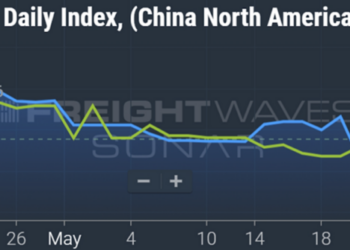Entering the final quarter of 2023, the freight market has moved into an era of somber recalibration. The optimism that jumped in Q3 is now tempered by more introspection, as signs emerge of a market that will remain subdued for a longer period. This new normal is less about the tumult of the past and more about steady adjustment to prolonged market softness.
The second half of 2023 has so far brought with it several major bankruptcies, leaving in their wake a new awareness among carriers and brokers of how fragile market equilibrium really is. As Q4 unfolds, much of freight’s executive class seems to be adopting a more defensive stance, suggesting collective acceptance of a “lower for longer” market scenario.
RELATED: Freight recession unlike any other in history
This conservative outlook is evident in the latest Freight Sentiment Indexes. North American supply chains now face the task of navigating a market that continues to downshift and has little hope of changing until Q2 2024 at the earliest.
The Q4 2023 Freight Sentiment Indexes are represented on a scale between negative 100 and positive 100, where higher numbers suggest positive sentiment or growth and lower numbers suggest pessimism or contraction. Shippers, brokers and carriers all answer the same survey questions. The results offer aggregated insights from hundreds of respondents into the industry’s health and expectations for the future.
In the first reading measured one year ago in Q4 2022, shippers registered an index of 12.68, indicative of modest confidence. That sentiment declined steadily through subsequent quarters, reaching a low of 8.32 in Q3 2023, and now is seeing a slight uptick to 9.79 in Q4 2023.
Brokers and 3PLs began with a lower sentiment of 9.84 in Q4 2022, which dipped further in Q1 2023 to 6.97. Their sentiment saw a fluctuation, climbing to 9.39 in Q2 2023 and peaking at 12.55 in Q3 2023, indicating a resurgence of confidence, before descending again to 8.78 in Q4 2023.
Carriers started with the lowest sentiment at 4.87 in Q4 2022, showing a slight improvement to 5.97 in Q1 2023 before taking a notable dip into negative territory at -0.52 in Q2 2023. This negative value may reflect specific challenges or a pessimistic outlook within the segment. There was a significant recovery to 9.17 in Q3 2023, only to decline once more to 4.41 in Q4 2023.
The overall sentiment index captures the cumulative sentiment across all segments, beginning at 9.13 in Q4 2022 and showing a gradual decrease to 6.48 by Q2 2023. A rebound to 10.01 in Q3 2023 suggests a temporary boost in confidence or improved conditions, which retreats to 7.66 in Q4 2023.
Note: Survey data was fielded in the first two weeks of October.
FreightWaves SONAR: Net changes in total trucking authorities (CDNCA.USA) have logged negative weekly figures consecutively for about a year, but capacity continues to outstrip volume.
Carrier sentiment: A market in search for equilibrium
Current sentiment among North American freight carriers reflects a sector searching for stability in Q4 2023, with the Freight Sentiment Index softening to 4.41 from a buoyant 9.17 in the previous quarter. This dip encapsulates the ongoing struggles in an industry attempting to right-size against a backdrop of excess capacity and economic uncertainty.
Data from recent months illustrates a truckload market that is still digesting the influx of new operating authorities, a stark contrast to the incremental growth in tender volumes since 2018. The disparity suggests carriers are wading through a capacity surplus, which has put a damper on the segment’s margins.
The economic turbulence that began in 2022 persists, with a demand curve that has not risen sharply enough to support the breadth of available capacity. This lag in demand is mirrored in the subdued sentiment figures, indicating that while the horizon holds promise, the immediate path remains fraught.
The sector’s shake-up, underscored by the shuttering of FreightTech darling Convoy and insights from industry leaders, underscores the challenges carriers face. These closures not only reflect the current overcapacity but also act as a catalyst for a much-needed market correction.
Some analysts provide a cautiously optimistic timeline for this correction, suggesting a realignment of supply and demand should materialize within a year and a half if the economy and carrier consolidation trends continue as they have. This prognosis aligns with data showing a rise in the exit rate of trucking authorities since late 2022, a potential harbinger of a more balanced market on the horizon.
RELATED: How long will the capacity correction take?
While 2024 may bring the balance that carriers seek, near-term profitability remains negative, albeit less so than in Q1 or Q2. This hesitance in near-term outlook is balanced by a stronger confidence in long-term profitability, which, despite a decline from the previous quarter, remains in positive territory.
Employment indexes present a mixed view, with immediate workforce sentiment slightly negative, hinting at cautious staffing strategies. In contrast, the longer-term perspective is more stable.
Investment sentiment has cooled, with the index retreating to 2.17, suggesting a wait-and-see approach as carriers gauge the timing and strength of the market’s upswing.
These indexes collectively narrate the tale of a sector in the throes of recalibration. With an eye on future stability, carriers are threading through the near-term challenges, their sentiment tempered by experience and the anticipation of an industry on the cusp of change.
FreightWaves SONAR: Outbound tender rejections (OTRI.USA) with outbound tender volume (OTVI.USA) over the previous five years. Despite steady increases in overall volumes through 2023, rejections have yet to rise off their historically low floor.
Broker sentiment: Navigating a narrowing path
Brokers and 3PLs are confronting a pronounced shift in sentiment as they close out Q4 2023, with overall freight sentiment having receded to 8.78 from a Q3 high of 12.55. This downturn is reflective of a broader constriction in the freight market, where volume contractions and tightened capital environments squeeze margins, testing the resilience of the brokerage sector.
Despite this dip, the nuanced year-over-year sentiment comparison reveals a sector potentially more buffered against the storm than asset-based carriers (though Convoy’s shuttering throws that idea into question). The nimble nature of brokers may afford them some agility to pivot in response to the evolving market dynamics, albeit within a more challenging landscape. Similar to carriers, they’re likely to continue to struggle until the market swings in carriers’ favor.
The stunning closure of Convoy, a digital brokerage that was recently among the most promising and best-funded upstarts in logistics, epitomizes current sentiment in the brokerage community. Like carriers, brokers are wrestling with a service overcapacity that fails to align with demand.
RELATED: Death from overfunding: An obituary for Convoy
This sentiment is reinforced by the broader financial caution seen in the logistics space. A notable slowdown in mergers and acquisitions signals a collective pause among investors, wary of committing in a volatile market, thereby straining liquidity and expansion prospects for brokers and 3PLs.
Within this contraction lies a bifurcated pathway for brokers: on one side, a landscape rife with challenges such as diminishing freight volumes and intensified competition, and on the other, opportunities emerging from market consolidation. Here, robust entities could strategically absorb the customer and talent reservoirs of less solvent competitors, positioning themselves advantageously for the eventual market uptick.
RELATED: Flexport acquires Convoy technology stack for undisclosed sum
Navigating through Q4 2023, brokers and 3PLs must walk the tightrope of managing operational efficiencies while fostering innovation, all in an era in which fiscal prudence is paramount. The subdued sentiment thus captures a snapshot of a sector at a crossroads, eyeing the potential for rebound but anchored firmly in the reality of today’s economic headwinds.
FreightWaves SONAR: The Federal Reserve Bank of Philadelphia’s General Activity diffusion index (PFIFA.USA). It forecasts the change in general business activity over the next six months for reporting manufacturing firms.
Shipper sentiment: Steady amid uncertainty
As Q4 2023 unfolds, shippers are feeling a marginal elevation in their overall freight sentiment, climbing to 9.79 from 8.32. But the numbers reveal a deeper narrative of cautious navigation through uncertain territory.
Near-term profitability has risen to 9.8, signaling a tempered but positive response to current market conditions. This uptick over Q3 reflects a cautious optimism as the industry navigates through excess capacity and elevated inventory levels, which continue to exert pressure on margins. Despite the immediate headwinds, the longer-term profitability outlook remains more positive, resting at 21.2, suggesting that shippers are banking on strategic adjustments and market corrections to bolster future earnings. This confidence likely stems from an anticipation of demand stabilization and a more balanced supply chain landscape ahead.
The workforce sentiments tell a more complex story. The near-term workforce sentiment drops to a mere 0.53, suggesting head counts will remain unchanged for now. Conversely, the slight improvement in longer-term workforce sentiment to 5.97 indicates that shippers are cautiously optimistic about future labor conditions, perhaps expecting a rebound in employment stability.
On the business investment front, there’s a noticeable retreat to 11.47, underscoring a strategic shift toward fiscal prudence. Investments are being more carefully weighed, with an inclination toward those that can deliver immediate value in streamlining operations or reducing overhead. This conservative approach to capital expenditure reflects a broader industry trend of risk mitigation.
Shippers are then portrayed in a state of guarded anticipation, their sentiment improved but tethered closely to the broader economy (which, depending on whom you ask, is either landing softly or about to tip into chaos). In the end, shippers — like carriers and brokers — are gearing up for what could be another challenging year.
Related articles and white papers
Shipper sentiment is slipping. Is the freight market turning?
White Paper – Freight’s Breaking Point: The Double Brokering Dilemma
FreightWaves announces 2024 FreightTech 100 companies
The post No one’s having much fun in this freight market appeared first on FreightWaves.














